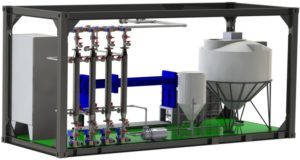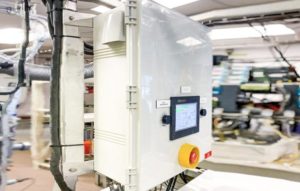
Selective Ion Removal Solutions: SilicaSelect
Saltworks proudly announces SilicaSelect, a new product which selectively targets silica in wastewaters while keeping treatment footprint and costs down.
Jun 27th 2018
Scale is a crust that forms on membranes, heat transfer surfaces, and on the inside of pipes as salts precipitate out of solution. Scale blocks flow, disrupts heat transfer, and increases energy requirements for water treatment systems. Simply stated, scale is bad news: it limits system performance and increases maintenance costs.
You can protect your plant’s productivity from scale when you are armed with an understanding of scaling water chemistry and the right technology. You can also push and maximize performance of your plant, if you understand the scaling ‘danger zone’.
Download our periodic table, which includes an easy-to-use guide and example. Keep reading below to learn more.
Scaling occurs when ion pairs reach their solubility limits and form salts. Ion pairs comprise positive cations and negative anions, and most scale is caused by ions that are multivalent pairs. Multivalent ions, such as calcium (Ca2+) and sulfate (SO42-), are more likely to cause scale than monovalent ions because they have lower solubilities and will precipitate earlier. Watch out, however, for one particular mono-multi pair—calcium (Ca2+) and fluoride (F–)—which can also cause scale.
Our chemists and engineers use the above periodic table of scaling compounds to easily check for concentrations of ions in water that might precipitate and affect evaporator or membrane system performance.
The solubility of an individual ion pair is the most essential information to use when designing a scale management strategy. However, scaling concentration limits can be affected by the temperature, pH, and mixed-ion chemistry of the water. Ions in mixed solutions tend to have higher solubilities than pure solutions, which can be difficult to predict, even with some of the software models that are available. We treat mixed-ion effects as an extra buffer that prevents scale.

Any heat transfer surface where scaling occurs will observe decreased efficiency and capacity. Although scaling is typically shown on metal surfaces, it can also form on membranes used in reverse osmosis systems and reduce membrane performance. In severe cases, scale can mechanically damage or rupture the membrane.
A plant that ignores scaling limits can experience equipment plugging and surface crusting, or be operating sub-optimally for leaving room to increase freshwater recovery. Time and money are wasted on either low performance or efforts to recover from a scaling event. Although carbonate scaling is easy to remove with acid, other scales take much more effort, such as using expensive chemical cleans or mechanical removal. It is best to know your water chemistry so that you can prevent scaling, rather than try to deal with it after it forms.
Follow these basic guidelines to help prevent scale build-up that leads to decreased performance and increased costs.
Contact an expert at Saltworks today to optimize your process and prevent scale formation.
Saltworks Technologies is a leader in the development and delivery of solutions for industrial wastewater treatment and lithium refining. By working with customers to understand their unique challenges and focusing on continuous innovation, Saltworks’ solutions provide best-in-class performance and reliability. From its headquarters in Richmond, BC, Canada, Saltworks’ team designs, builds, and operates full-scale plants, and offers comprehensive onsite and offsite testing services with its fleet of mobile pilots.

Saltworks proudly announces SilicaSelect, a new product which selectively targets silica in wastewaters while keeping treatment footprint and costs down.

Real-time measurement provides prompt feedback for controls. A real-time sensor can help to optimize your process, reduce risk, and minimize operational and maintenance demand. Saltworks has developed a new real-time sensor—that is simple and robust—to operate in the high-TDS range.

There are four fundamental types of industrial evaporators and crystallizers used for wastewater treatment, brine management, or improving water reuse. Lower your risks and improve costs by understanding the trade-offs between the different evaporator types.

The many options for managing brine, a term for saline wastewater from industrial processes, fall under two categories: brine treatment and brine disposal. Brine treatment involves desalinating the brine for reuse and producing a concentrated brine (lower liquid waste volume), or residual solids (zero liquid discharge).